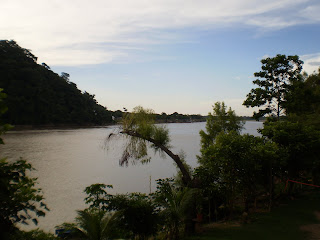A very inspired update this time - I'm writing on a dugout canoe along the Beni River as we return to Rurrenabaque having just completed our tour of the Amazon basin.
Our tour consisted of two parts, both of which left from Rurrenabaque, the major town (if you want to call it that) on the periphery of the Bolivian Amazon. First was a tour of the Pampas wetlands, followed by a tour of the jungle area that comprises the Madidi National Park - a total of 5 days.
In hindsight, the Pampas was no greater than a glorified zoo. Although we did see more wildlife in the wetlands (caimans, monkeys, pink river dolphins etc) it consantly felt as though we were walking through fenced off farmland at the back of a paddock. Furthermore, many of the animals seem so decensitised to tourists that at times if felt like a circus. We heard that there had been cases of dead anacondas being found due to poisoning from Deet - not exactly sustainable tourism by any stretch of the imagination. The jungle tour on the other hand was very much a rainforest trek - spiders, butterflies, massive trees, monkeys in a more natural setting, hoards of wild pigs and even a couple of tucans. If I had the chance again I would definitely opt for the jungle tour.
Rurrenabaque:
Calling Rurrenabaque is a massive stretch. It consists of primarily two or three streets, and it's airport resembles a house with a dirt runway/paddock. That said, it is really cool and has a very 'tropical island' vibe despite not being an island. One tip I can give is to definitely fly! We didn't hear one good thing about the 20 hour bus from anyone (breakdowns, unpaved roads etc).
Our hostel for the interim nights (El Lobo Hostel) was also located on the Beni River and had no walls - very 'Amazon' and very cheap! BS25 p/n



The two tours were ran by Indigina Tours which from what we can gather are amongst the more responsible of the operators. Transport to the Pampas was via a 3 hour jeep ride to Santa Rosa followed by a 2.5 hour boat ride to the eco-lodge. The jungle tour went the opposite way by boat along the Beni River. It was 1.5 hours to the entrance to the park, and a further 2.5 hours to the eco-lodge. The Madidi National Park is alot more sensitive and as such is guarded by the military. The Pampas is protected by a local with a rope that lowers it from the comfort of their house when a jeep approaches. Quite peculiar.







































